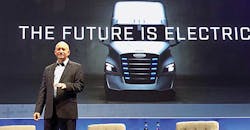DTNA CEO says battery-electric vehicles will pave the way to zero-emission commercial transport
ROGER Nielsen, president and chief executive officer of Daimler Trucks North America (DTNA), the largest commercial vehicle manufacturer in North America, declared battery-electric vehicles as the solution to achieve emissions-free commercial transportation in North America. He was the keynote speaker at the 2019 Advanced Clean Transportation (ACT) Expo in Long Beach, California April 23-26.
Speaking to a crowd assembled at this year’s ACT event, Nielsen said, “The road to emissions-free transportation is going to be driven with battery-electric vehicles. I believe the future is electric.”
The road to emissions-free driving, he continued, does not include plug-in hybrids for DTNA. Near-zero-emissions natural gas medium- and heavy-duty vehicles are currently available and will continue from Freightliner as an interim solution until full commercialization of the battery-electric Freightliner eM2 and eCascadia. The company sees potential for hydrogen fuel cells to extend battery-electric truck range, but does not see it as viable in the near term.
The vision of electric vehicles does not exclude fuel cells: “I can see a glimpse of it over the horizon, but it will not be this generation of engineers who will be delivering it,” Nielsen said.
To hasten the arrival of zero-emission commercial transport, three goals must first be achieved.
First, the industry must work together to establish a common battery-electric vehicle charging infrastructure. Daimler AG is a founding member of CharIN, an organization whose aim is to standardize charging requirements for electric vehicles, including commercial vehicles.
Second, batteries must become cheaper, lighter, and more powerful. DTNA is leveraging its global network to develop proprietary batteries for its commercial vehicles that meet the standards of quality, durability, and integration that customers demand.
Finally, the real cost of ownership for customers must be strengthened through increased incentives, decreased maintenance costs, and cheaper energy costs. Organizations like the South Coast Air Quality Management District (SCAQMD) will be instrumental in creating a viable business case for electric trucks. A $16-million grant from SCAQMD partially funds the Freightliner Electric Innovation Fleet.
Testing is the key to ensuring electric vehicles are ready for commercialization. DTNA and its global affiliates exhaustively test their electric vehicles over millions of miles on the track and in the real-world.
With its first electric truck already in customer hands, DTNA plans to put nearly 50 on the road by the end of the year. This includes a test fleet and the Freightliner Electric Innovation Fleet shared between Penske and NFI.
Affiliated brands Fuso and Mercedes-Benz trucks have already begun deliveries of the battery-electric eCanter and eActros in Asia, Europe, and North America. By the end of 2019, nearly 200 battery-electric vehicles powered by Daimler will be deployed for testing, co-creation, and collaboration worldwide.
“For our engineers, these early customer partners are our test drivers,” said Nielsen. “We want them to test these vehicles to their extremes. We want to see the failures so we can engineer solutions.”
To enable rapid scale-up of thoroughly tested and validated electric vehicles, DTNA announced during ACT that they will begin converting the Portland manufacturing plant to produce electric Freightliners. The plant lies just blocks from DTNA’s LEED Platinum headquarters. Plant renovations begin next year with series production scheduled to begin in 2021.
The company’s decision to bring electric vehicle production to Portland was based on multiple factors, including Portland’s proximity to the huge demand for electric vehicles in California. In addition to production, the Portland manufacturing facility will also host a battery storage facility and an electric vehicle co-creation center, where the e-consulting team will collaborate with customers. Here they will integrate electric trucks into their fleets from order intake through the second life of the truck.
DTNA’s school bus division, Thomas Built Buses (TBB), is nearly ready to begin producing Proterra-powered Saf-T-Liner eC2s. The buses will be assembled at TBB’s school bus manufacturing plant in High Point, North Carolina.
Last year DTNA formed the Freightliner Electric Vehicle Council composed of 30 customers with strong use-cases for electric trucks to further drive its sustainable transportation program. The company is working with the council members to ensure a holistic approach to launching electric trucks. Members of the customer council benefit from co-development of deployment strategies for battery electric vehicles including applicable use cases, current legislation and requirements for facilities, charging infrastructure, and service support.
